Содержание
- 2. Content Behavioralism Post-behavioralism Systems theory Modernization theory
- 3. Behavioralism Behavioralism is an approach in political science, which emerged in the 1930s in the United
- 4. Post-behavioralism Post-behavioralism also known as neo-behavioralism was a reaction against the dominance of behavioralist methods in
- 5. Post-behavioralism Post-behavioralism challenged the idea that academic research had to be value neutral and argued that
- 6. Systems theory In simple terms, Easton's behavioral approach to politics, proposed that a political system could
- 8. Modernization theory Modernization theory is a theory used to explain the process of modernization within societies.
- 9. References http://wps.prenhall.com/hss_roskin_politic http://www.rhul.ac.uk/politicsandir http://en.wikipedia.org/wiki
- 11. Скачать презентацию
Слайд 3Behavioralism
Behavioralism is an approach in political science, which emerged in the 1930s
Behavioralism
Behavioralism is an approach in political science, which emerged in the 1930s

Behavioralism seeks to examine the behavior, actions, and acts of individuals – rather than the characteristics of institutions such as legislatures, executives, and judiciaries – and groups in different social settings and explain this behavior as it relates to the political system.
Слайд 4Post-behavioralism
Post-behavioralism also known as neo-behavioralism was a reaction against the dominance of
Post-behavioralism
Post-behavioralism also known as neo-behavioralism was a reaction against the dominance of

Слайд 5Post-behavioralism
Post-behavioralism challenged the idea that academic research had to be value neutral
Post-behavioralism
Post-behavioralism challenged the idea that academic research had to be value neutral
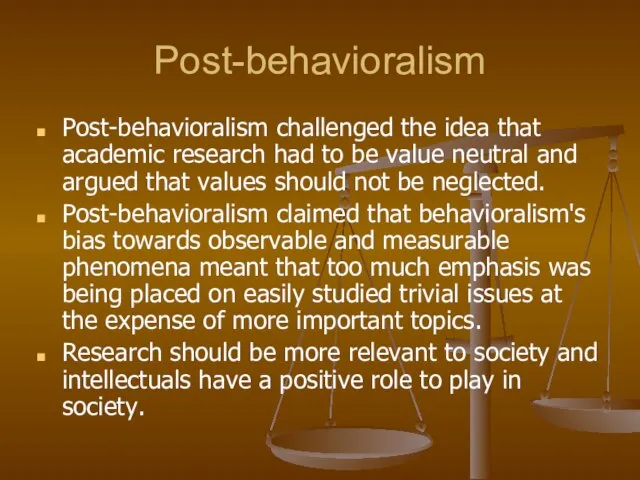
Post-behavioralism claimed that behavioralism's bias towards observable and measurable phenomena meant that too much emphasis was being placed on easily studied trivial issues at the expense of more important topics.
Research should be more relevant to society and intellectuals have a positive role to play in society.
Слайд 6Systems theory
In simple terms, Easton's behavioral approach to politics, proposed that a
Systems theory
In simple terms, Easton's behavioral approach to politics, proposed that a
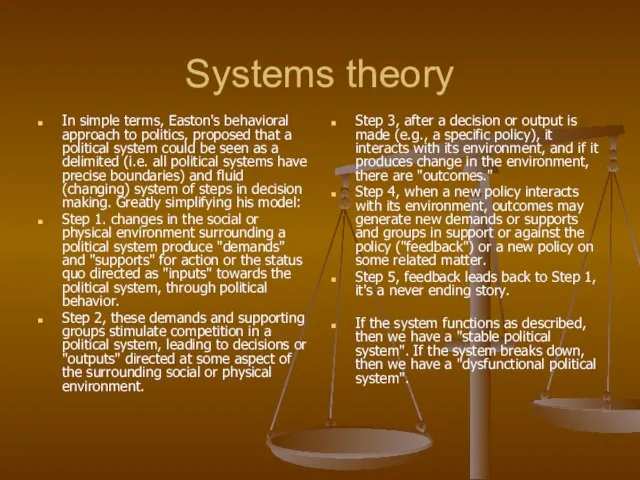
Step 1. changes in the social or physical environment surrounding a political system produce "demands" and "supports" for action or the status quo directed as "inputs" towards the political system, through political behavior.
Step 2, these demands and supporting groups stimulate competition in a political system, leading to decisions or "outputs" directed at some aspect of the surrounding social or physical environment.
Step 3, after a decision or output is made (e.g., a specific policy), it interacts with its environment, and if it produces change in the environment, there are "outcomes."
Step 4, when a new policy interacts with its environment, outcomes may generate new demands or supports and groups in support or against the policy ("feedback") or a new policy on some related matter.
Step 5, feedback leads back to Step 1, it's a never ending story.
If the system functions as described, then we have a "stable political system". If the system breaks down, then we have a "dysfunctional political system".
Слайд 8Modernization theory
Modernization theory is a theory used to explain the process of
Modernization theory
Modernization theory is a theory used to explain the process of
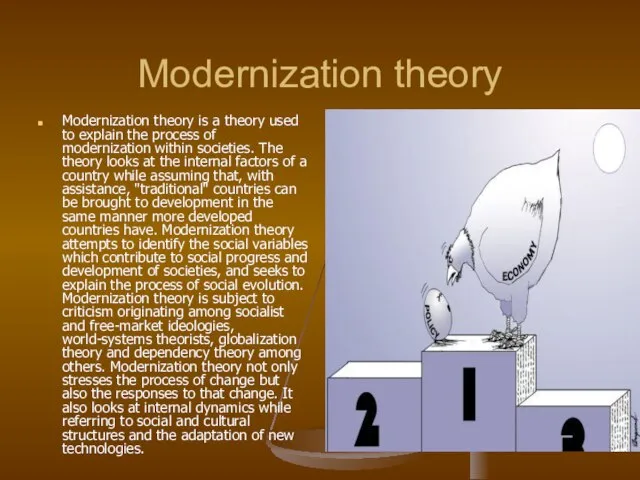
Слайд 9References
http://wps.prenhall.com/hss_roskin_politic
http://www.rhul.ac.uk/politicsandir
http://en.wikipedia.org/wiki
References
http://wps.prenhall.com/hss_roskin_politic
http://www.rhul.ac.uk/politicsandir
http://en.wikipedia.org/wiki
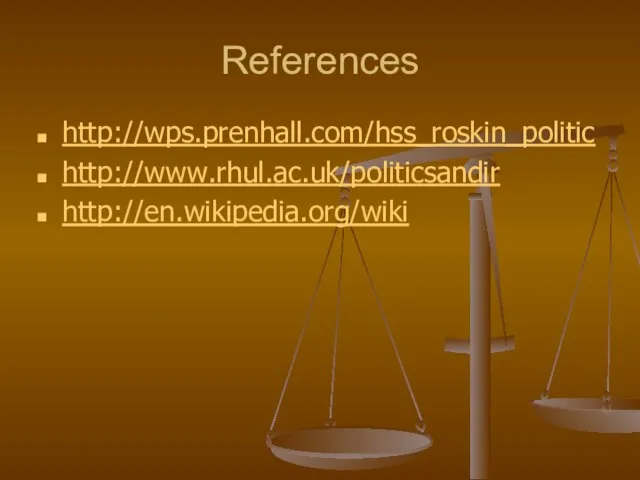

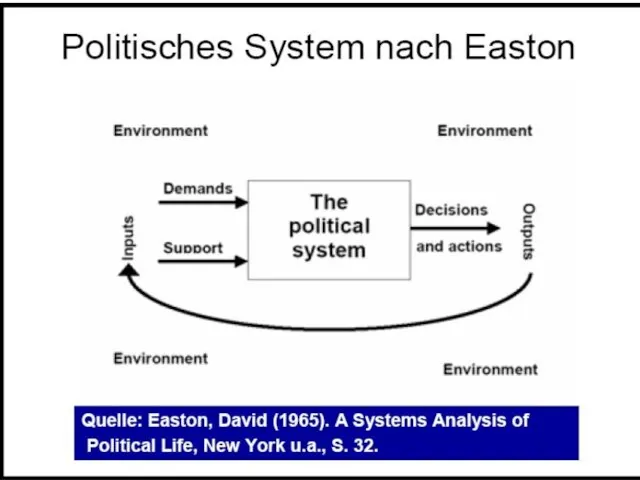
 Формирование УУД в учебной деятельности
Формирование УУД в учебной деятельности Основы программированияна Visual Basic
Основы программированияна Visual Basic Корпус общественных наблюдателей. Всероссийское молодежное движение
Корпус общественных наблюдателей. Всероссийское молодежное движение RRE Introduction and Conclusion
RRE Introduction and Conclusion в цифровых каналах коммуникации
в цифровых каналах коммуникации Подготовка к ЕГЭ по обществознанию
Подготовка к ЕГЭ по обществознанию Организаторское поведение
Организаторское поведение Белянская Светлана Ивановна, учитель ОБЖ, высшая категория
Белянская Светлана Ивановна, учитель ОБЖ, высшая категория Биологическая статистика
Биологическая статистика Письмова мова веньянь
Письмова мова веньянь Детство, опалённое войной
Детство, опалённое войной Constitution of the United Kingdom of Great Britain
Constitution of the United Kingdom of Great Britain Смешанная республика
Смешанная республика Urok_14_ONZ_stepen_s_ratsionalnym_pokazatelem (1)
Urok_14_ONZ_stepen_s_ratsionalnym_pokazatelem (1) Sayt.online - створення сайтів під заказ і реклама
Sayt.online - створення сайтів під заказ і реклама народное художественное творчество
народное художественное творчество  Презентация
Презентация Единый деловой стиль одежды в школе
Единый деловой стиль одежды в школе Звук [ ц ]. Буквы Ц, ц
Звук [ ц ]. Буквы Ц, ц Экспертные системы
Экспертные системы Лукашенко Ю.В. ПСИХОЛОГИЯ ЛИЧНОСТИ Часть 1
Лукашенко Ю.В. ПСИХОЛОГИЯ ЛИЧНОСТИ Часть 1 О КОМПАНИИ Компания «Vladi Toys» – производитель качественных красочных пазлов и увлекательных конструкторов на основе мягкого вспен
О КОМПАНИИ Компания «Vladi Toys» – производитель качественных красочных пазлов и увлекательных конструкторов на основе мягкого вспен Основы гражданского права
Основы гражданского права  История и этапы возникновения Городецкой росписи
История и этапы возникновения Городецкой росписи ВЫБОР ПРОФЕССИИ – ЭТО СЕРЬЁЗНО
ВЫБОР ПРОФЕССИИ – ЭТО СЕРЬЁЗНО Исследовательская работана тему:
Исследовательская работана тему: Корпус канализационно-насосной станции
Корпус канализационно-насосной станции Презентация на тему Безопасность на дорогах для школьников младших классов
Презентация на тему Безопасность на дорогах для школьников младших классов